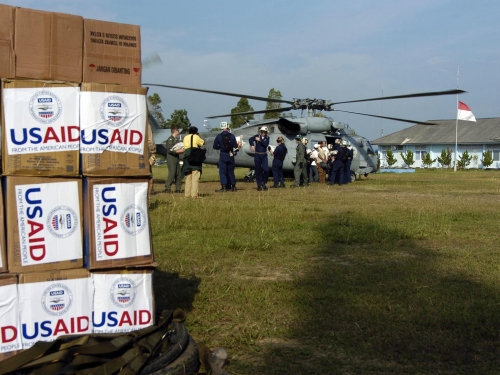
This article was originally published by Harvard International Review on 11 March, 2015.
Public opinion on United States foreign aid varies widely depending on who is being asked. However, one domestic opinion on the matter is clear: we spend too much on foreign aid. In a 2013 poll conducted by the Pew Research Center, the majority of Americans wanted to either maintain or increase spending for almost all US government initiatives. Foreign aid was the only exception. Facing a national debt of more than sixteen trillions while news of humanitarian initiatives in foreign nations proliferate, it is not surprising that so many Americans believe the US should be cutting back on foreign aid. However, much of this sentiment is based on an ongoing misconception — the majority of Americans believes the US government spends 28 percent of its federal budget on foreign aid. In reality, foreign aid accounts for only 0.7 percent. Military aid, which is accounted for separately, makes up another 0.5 percent.
Given the enormity of the US budget, even less than one percent translates into a large sum. Indeed, in the fiscal year of 2012, the US spent more than 23 billion in foreign assistance, which is more than the grow domestic products (GDPs) of Belize and Liberia combined. The reaction against foreign aid, however, is about more than the sheer amount of foreign aid being given. There is also an underlying belief that foreign aid to countries such as Afghanistan and Egypt is being wasted on corrupted regimes. Rather than addressing global health and child survival, which accounts for 21% of total aid, taxpayers’ money is being funneled into the pockets of dictators.
Senator Rand Paul expressed his frustration with the lack of accountability by aid recipients when he stated, “How can we decide if foreign governments are up to no good with our tax dollars when our own government regularly ignores or covers up any wrongdoing?” The US government is portrayed by politicians as a misguided and wasteful donor, while the countries receiving aid are made out to be a lost cause. However, both depictions are far from the truth.
Most US development aid does not even go to governments— about 85 percent goes to US-based government contractors and non-governmental organizations (NGOs). The aid that is given to governments of developing nations does not simply work to bolster corrupt and oppressive regimes. Foreign aid is not unconditional. It is often used as an incentive for governments to increase their financial transparency and improve their management of public revenues.“It is not surprising that so many Americans believe the US should be cutting back on foreign aid. However, much of this sentiment is based on an ongoing misconception.”The United States Agency for International Development, the principal agency responsible for development aid, has mechanisms in place to guard against fraud and abuse in the usage of aid. The Millenium Challenge Corporation, a US development agency, works only with governments with the highest performance on a set of indicators including transparency and anticorruption efforts.
Some opponents of US foreign aid claim that the US has gained little from its generous foreign assistance, even when the money is used in the right places. In fact, the US has tremendous interest in the development and modernization of other nations. When nations are stable and able to participate actively in the global economy, the US and the rest of the world benefits. On the other hand, the direct correlation between US foreign aid investment and its political interests has caused distrust and skepticism from many organizations in aid-receiving nations. Yet, the fact of the matter is that the US is not simply wasting its federal revenue when it tries to address global issues like child hunger and refugee assistance. How stable a nation on the other side of the world is and how healthy its people are have direct implications on the US.
Foreign assistance is not without its flaws. There are numerous instances such as the one that occurred in Afghanistan in 2013, when the Office of the Special Inspector General for Afghanistan Reconstruction charged the Partnership Contracts for Health, a USAID program, for more than fifty deficiencies in financial practices. Such incidents require us to evaluate our programs and operations— it does not provide a justification for unabashedly cutting foreign aid. For all the reaction against foreign aid, 81 percent of the US public still holds believes that developed countries have “a moral responsibility to work to reduce hunger and severe poverty in poor countries.” And for all the incidents of misuse and corruption in foreign assistance, there are many more cases in which foreign aid has transformed lives and uplifted communities. When it comes to foreign aid, the question we should be asking is not how can we do less, but rather, how can we do better?
Alice C. Hu is a staff writer for the Harvard International Review. She contributes primarily to the Features and Blog sections.
For more information on issues and events that shape our world, please visit ISN Security Watch or browse our resources.

